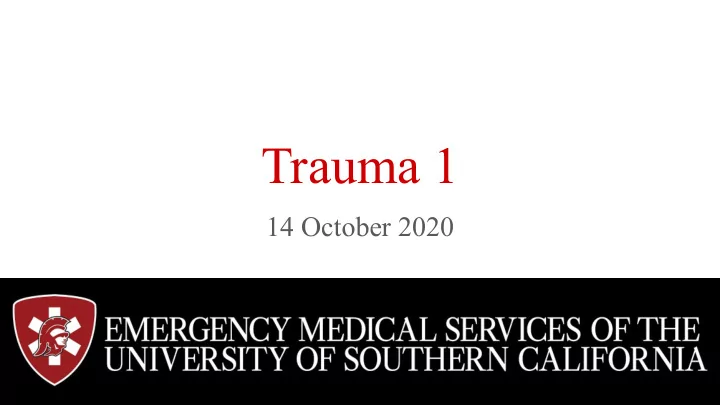

Trauma 1 14 October 2020
Initial Assessment - C-spine - Vitals based on importance - Treat obvious injuries first - Arterial bleeding? SAMPLE can wait. - Rapid trauma - what do we look for? - DCAPBTLS
Skull Injuries - Bleeding – Loosely cover site with sterile gauze – Check for CSF – Do NOT try to stop blood flow – Do NOT insert NPA (this is a contraindication!) – C-spine precautions – Probability pt. will vomit → suction
Eye Injuries - Foreign Objects - Irrigate with saline, medial to lateral - Do not attempt to remove an object from the cornea - Impaled - Stabilize with roller gauze (donut over eye and wrap gauze around head) - Chemical - Flush for 20 min - Thermal - Dressings moistened with sterile saline and rapid transport
Eye Injuries - Blowout Fracture - Check PERRL - Contacts should be kept in eye unless chemical present - Notify ALS if pt wear contacts - Tx: RAPID TRANSPORT
Nose Injuries - Epistaxis - Have the patient sit and lean forward - Apply direct pressure - Pinch nostrils - Hold rolled gauze between the upper lip and gum - Apply ice to constrict blood vessels - Look for CSF in the blood - Stain gauze with a small amount of blood - CSF is indicated by a lighter “halo” of fluid surrounding the blood
Neck Injuries - Apply direct pressure, using a gloved fingertip if needed - Apply a sterile, occlusive dressing - Tape down on four sides - Want to avoid embolism - Use roller gauze to secure the dressing around and under the opposite shoulder - Look out for subcutaneous emphysema - Monitor respirations
Mouth Injuries - Loose Teeth - Save in a container of sterile saline or milk - Bleeding - Check airway - Turn left-lateral - Prepare to suction - Apply direct pressure
Soft Tissue Injuries - Hematoma - Blood that collects within damaged tissue or in a body cavity, due to a large blood vessel being damaged and bleeding rapidly - Treatment - Splint, CMS, look for signs of shock - This can lead to compartment syndrome
Open Injuries - Abrasion - Clean with sterile saline - Apply bandage or dressing - Avulsion - Clean and place flap back in place - Control bleeding - Apply dressing
Open Injuries Impaled Object - Splint and stabilize - Only remove an impaled object if it interferes with CPR or airway Gunshot Wound 1. Look for entry and exit wound 2. Control bleeding 3. Provide O2 4. Check for shock
Pneumothorax - Open Pneumothorax or Sucking Chest Wound - Sterile occlusive dressing - Tape three sides down - Auscultate every five minutes - “Burp” the dressing if absent lung sounds develop - Spontaneous Pneumothorax - Due to a weak area on the surface of the lungs, known as a bleb - Patient will report sudden chest pain and shortness of breath - Be careful not to confuse this with angina or MI - Patient history!
Pneumothorax - Tension Pneumothorax - Caused by a completely collapsed lung - Can’t ventilate because pressure will accumulate - Symptoms - Diminished breath sounds - ALOC - Distended neck veins - Tracheal deviation to the opposite side (late sign)
Abdominal Injuries - Evisceration - Soak big trauma dressing in sterile saline - Secure with occlusive dressing - Do NOT touch exposed organ - Do NOT try to pack organs back
Amputations - Do NOT allow body part to freeze or come into direct contact with ice - Keep the body part viable for reattachment if possible - Treatment 1. Control bleeding 2. Wrap body part in sterile gauze 3. Place in plastic bag 4. Chill on ice
Recommend
More recommend